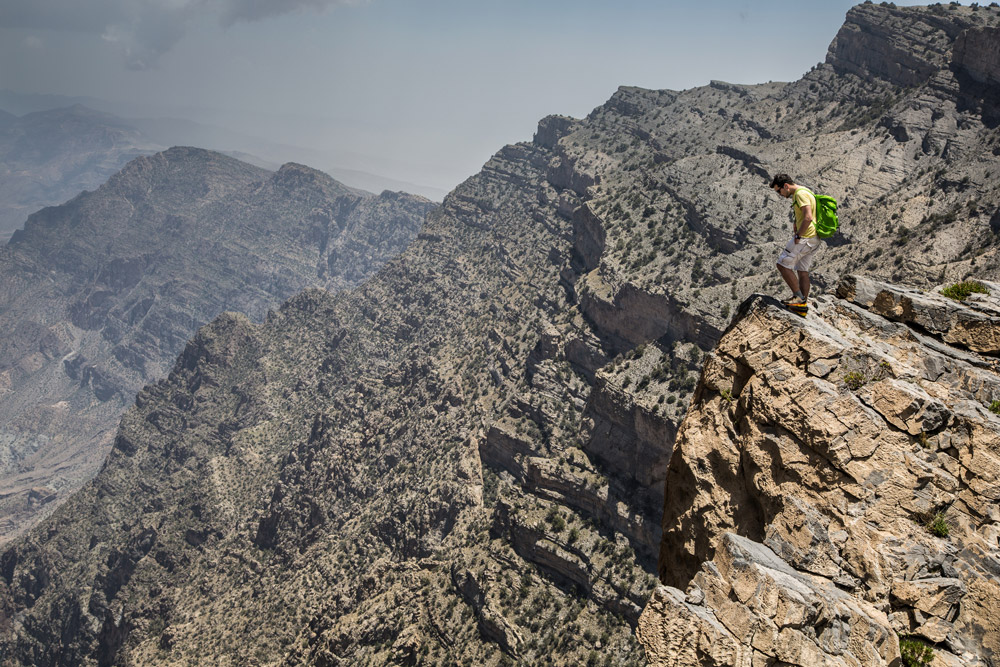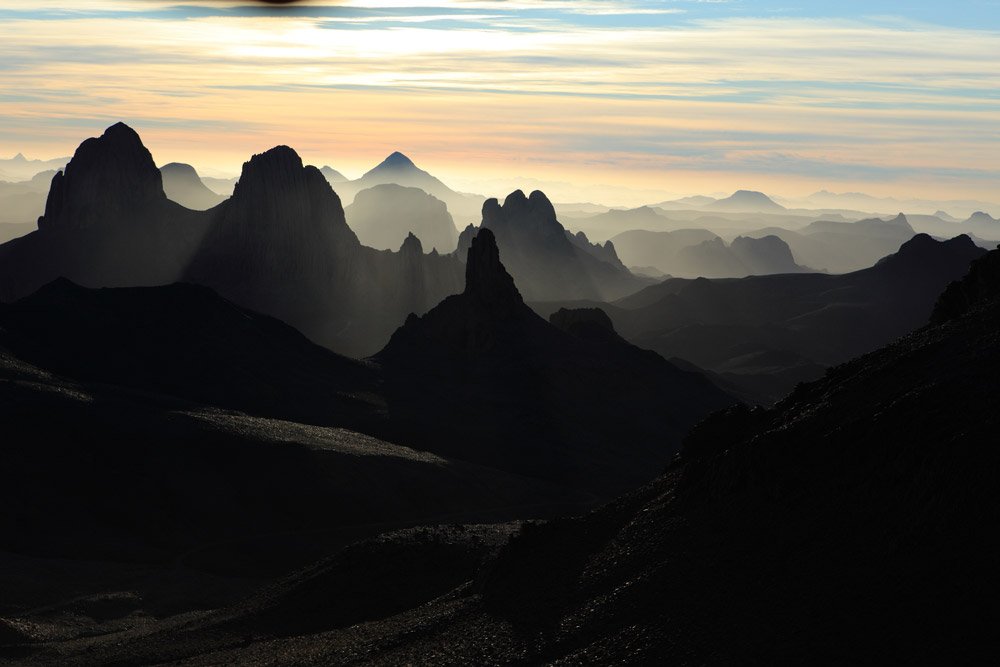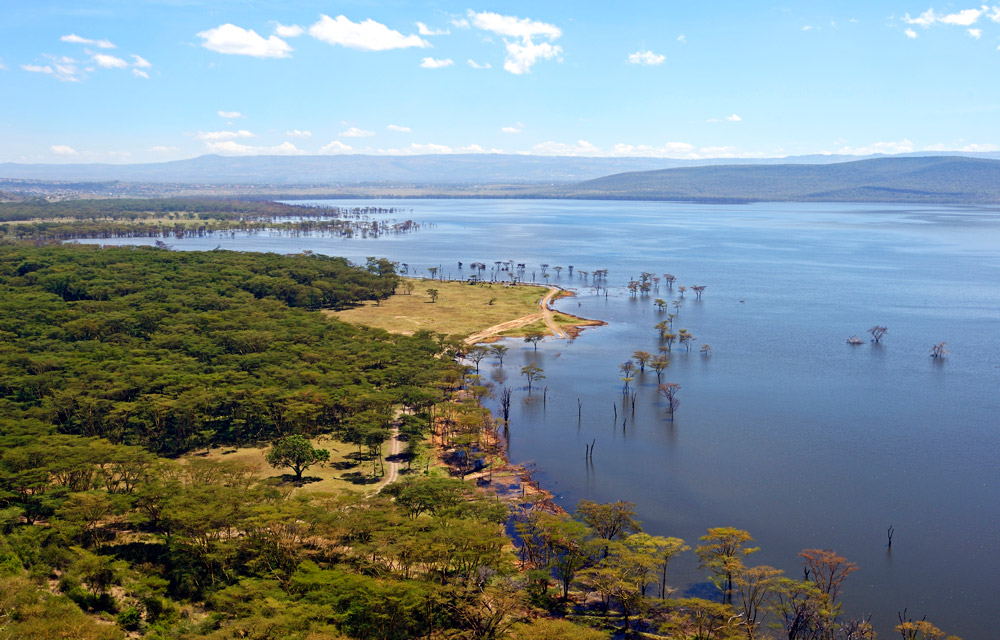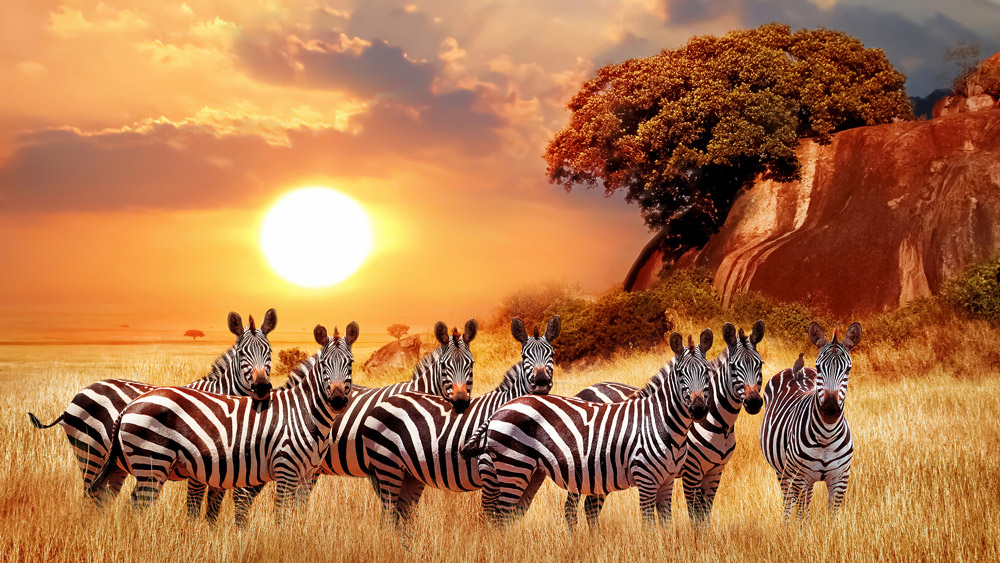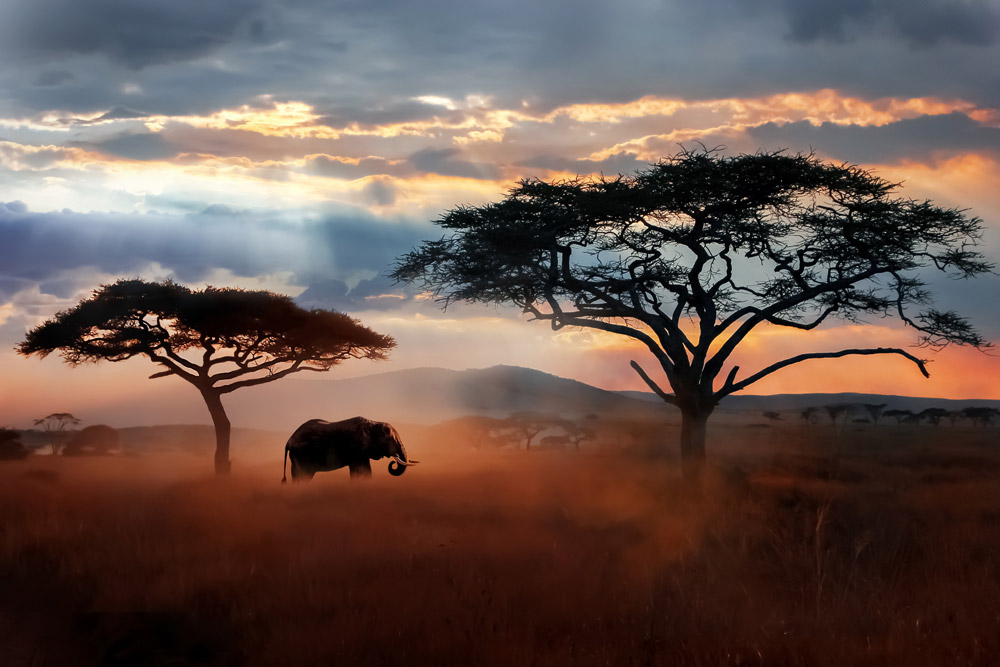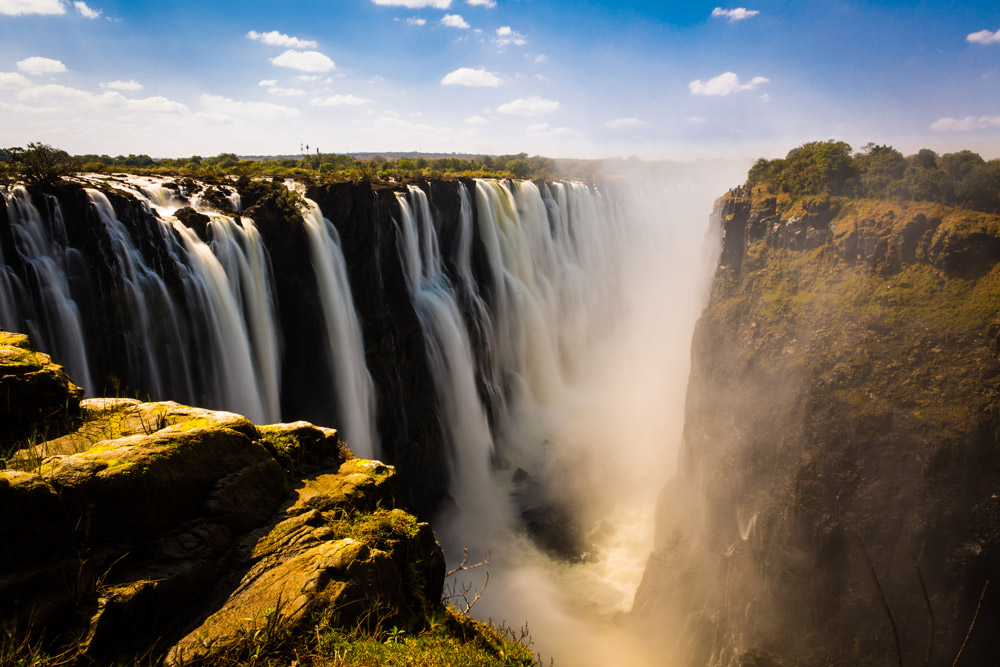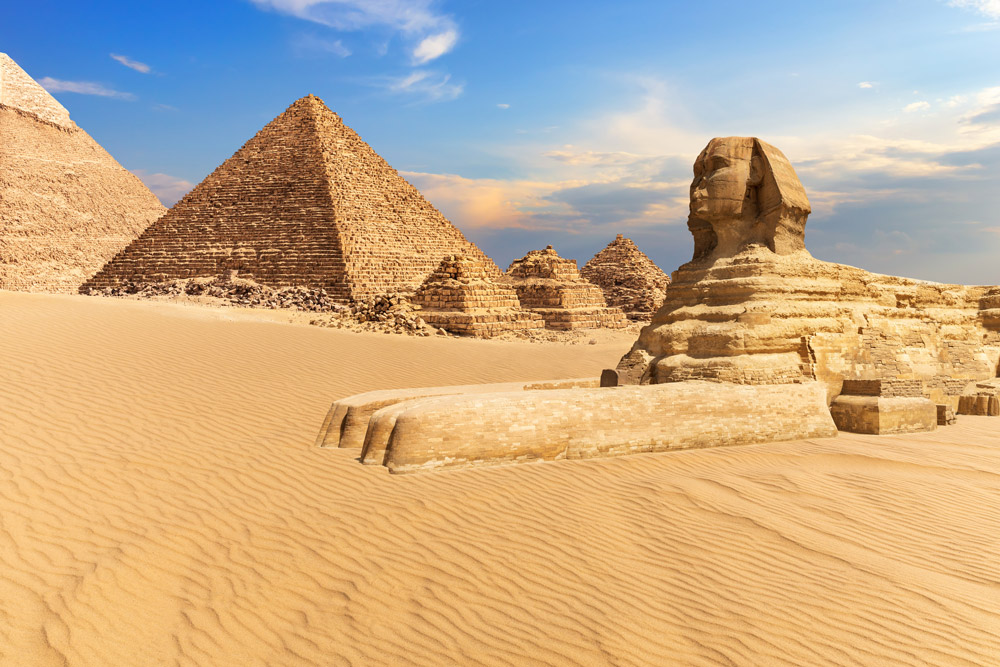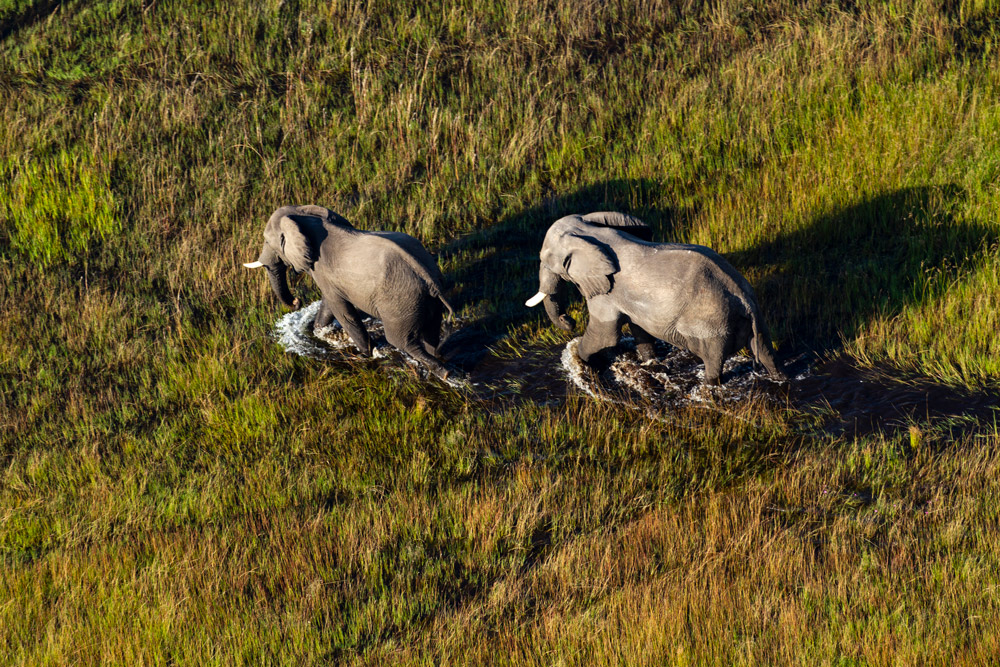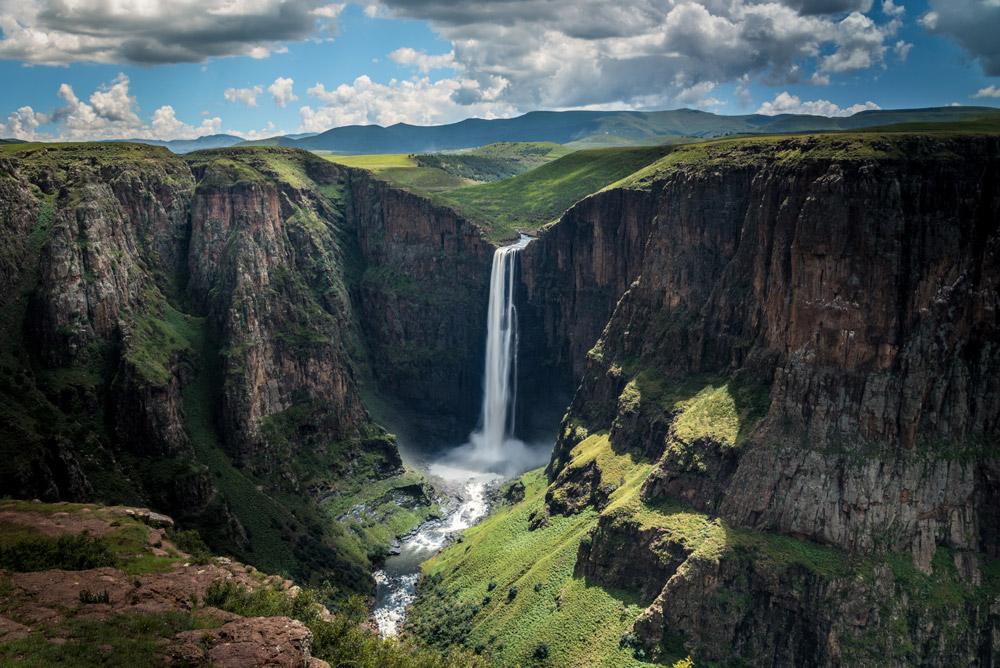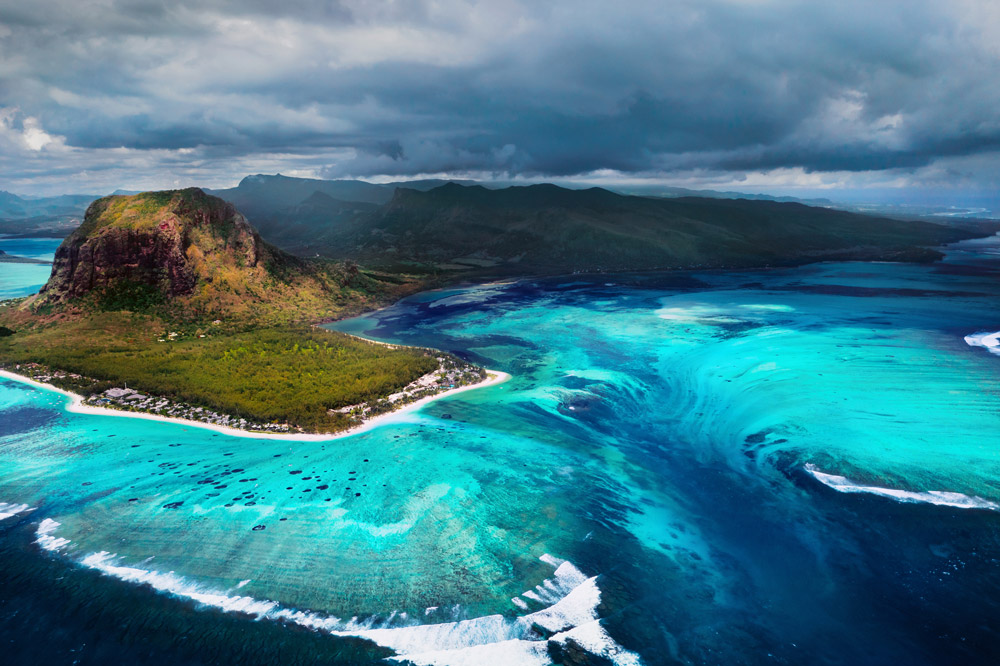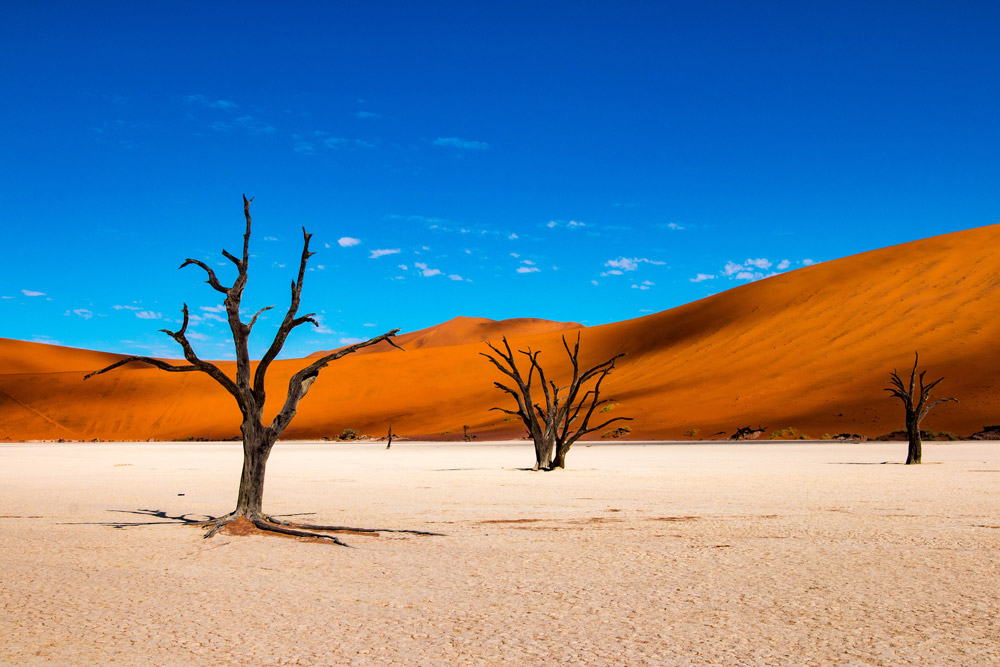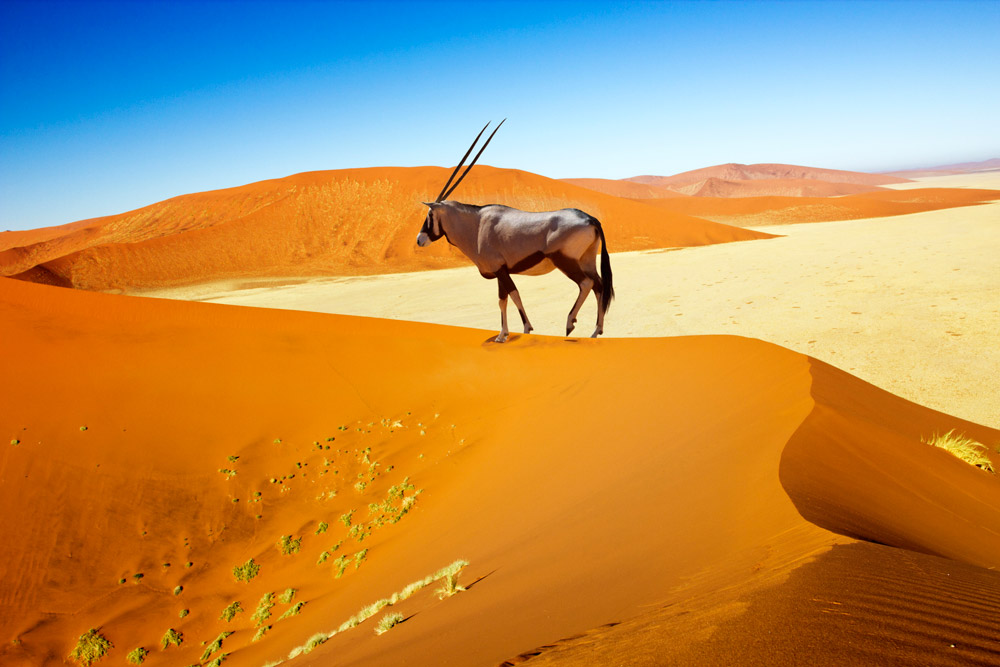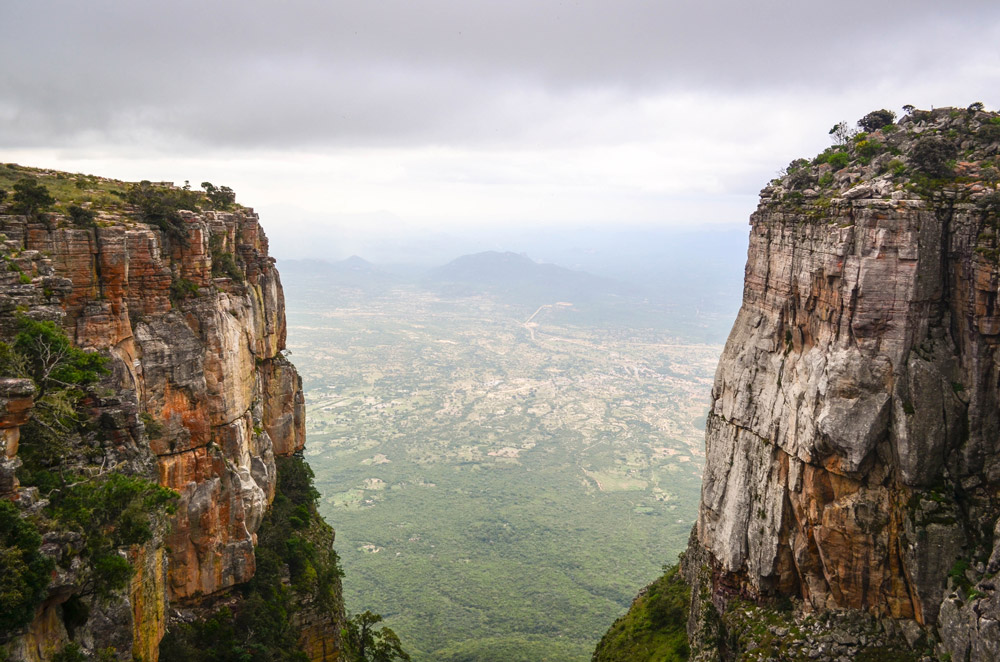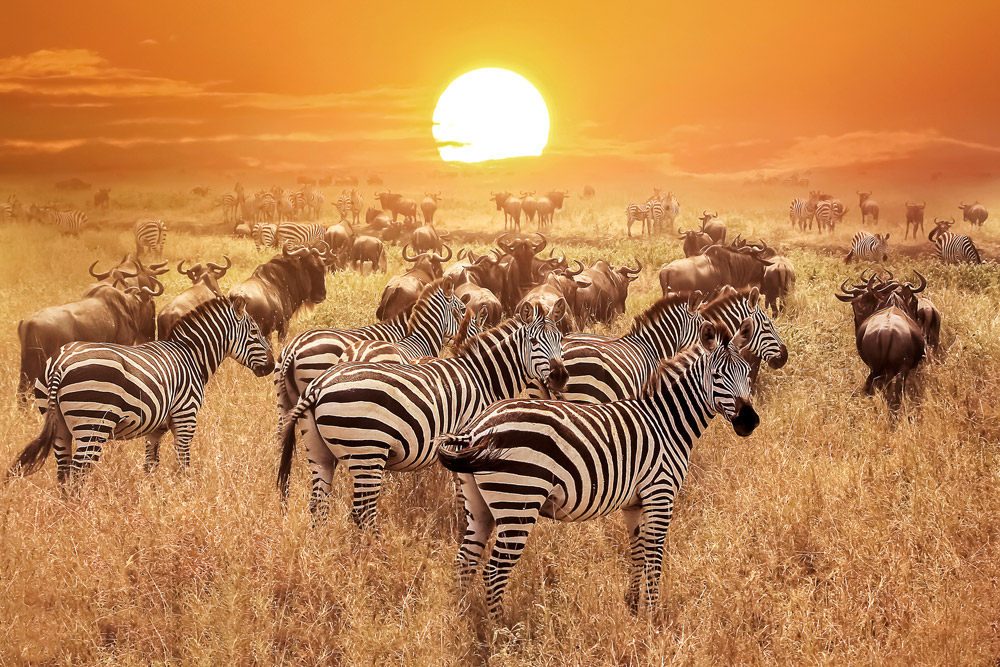So while it’s clear that Africa is a treasure trove of natural and cultural riches, intrepid travelers have got to start someplace! That’s why we’ve picked the ten must-visit places below, which are guaranteed to capture your imagination and earn a spot on your bucket list.
10 Most Beautiful Places in Africa
Do your travel dreams involve being outdoors, enjoying all that nature has to offer? Come with us on a virtual tour of the most beautiful places in Africa!
1. Tundavala Gap, Angola
Angola has some of the most spellbinding panoramic scenes of all countries in Africa. In particular, the Tundavala Gap or Tundavala Fissure, which sits between the Angolan cities of Namibe and Lubango, captures the essence of Angola’s beauty. Tundavala perches at the rim of the Serra da Leba escarpment at an altitude of 2600 meters. The valley below it plunges 1200 meters, forming a humongous abyss that channels towards the Atlantic Ocean. It is the most prominent geological attraction in the Huíla Province of Angola, and one of the most beautiful places in Africa. The void of the Tundavala Gap drops sharply in a wavelike pattern towards the beaches at Namibe. And at the same time, the Serra da Leba range of mountains forms the background of this to-die-for vista. The Tundavala Gap is a thrill-seeker’s paradise. Firstly, you can go for a hike up the Gap for the spectacular views and dizzying descent. And secondly, its sheer rock faces and forest landscapes are perfect for natural photography. This is indeed the perfect place to draw closer to nature.
2. Sossusvlei Dunes, Namibia
Namibia is home to Africa’s largest conservation area, and its famous red dunes make it one of the most beautiful places in Africa. The Sossusvlei Dunes, in their unique red, orange, and pink shades, are some of the most photographed of Africa’s features. The dunes create a spectacular surrealistic landscape that is the object of much media attention. Consequently, you will find Namibia’s beautiful dunes in music videos, commercials, and on film. Sossusvlei in Namibia’s coastal desert is a clay and salt pan ringed by red dunes. The name Sossusvlei originates from a local dialect Nama and has a little Afrikaans too. ‘Sossus’ in Nama means a dead end, while ‘vlei’ in Afrikaans is a shallow lake or marsh. The ‘dead-end lake’ of Sossusvlei forms where the red dunes meet the Tsauchab River and halt its progress. In a rare heavy rainy season, the river forms a lake that draws in tourists by the thousands to the area. The lake forms a remarkable site featuring red dunes surrounding water in a desert. The dunes are some of the oldest in the world, forming through the extensive action of ocean, river, and wind currents. Sossusvlei dunes are a natural wonder, never shifting their faultless arc shapes that rise to above 300 meters. Big Daddy, for example, is Sossusvlei’s most iconic dune. Hikers love to climb up its 325 meters height for the pleasure of viewing the dry and dark camel thorn tree landscape below on Dead Vlei. Other attractions around Sossusvlei are the Sesriem canyon’s vertical cliffs and rock formations. Namibia has scorching hot desert temperatures, but Sossusvlei’s heat is milder between July and November.
3. Le Morne Brabant, Mauritius
Exotic Mauritius has a lot to offer to the traveler looking for picture-perfect sites and attractions. The bucket list location we’ve chosen here is Le Morne Brabant. Le Morne Brabant is a magnificent basaltic mountain that rises to an altitude of 556 meters. At the top is a 12-hectare (30 acres) summit that offers spectacular views of the beautiful surrounding lagoon. The mountaintop also has stunning overhanging steep slopes as well as caves that are a must-see. The dramatic Le Morne Brabant is excellent for hikers offering superb views of the mountain’s underwater waterfall to climbers. There are also exceptional views of the Le Morne beach to savor on your way up, so bring along a good camera. This natural and unusual wonder is truly one of the most beautiful places in Africa. It’s a magical destination which holds a deep cultural and historical significance such that the surrounding area is a UNESCO World Heritage Site. Le Morne Brabant’s cultural significance stems from Mauritius’s history as a slave refuge. Slaves would escape the plantations in Madagascar and head to the island, where its isolated cliffs and forests were the principal form of shelter and protection for escapees. There is a monument at the foot of the mountain that commemorates the abolition of the barbaric trade.
4. Maletsunyane Falls, Lesotho
Every country in Africa has an outstanding feature, and Lesotho’s is Maletsunyane Falls. This beautiful site near Semonkong, a town in Lesotho, is a geological gem. Maletsunyane Falls is one of the highest waterfalls in Southern Africa. Its water plunges to depths of 196 meters (Victoria Falls has a 108 meters drop, for reference). Maletsunyane Falls creates such an epic scene; it looks like a set in a fantasy feature film. This magnificent setting is an uninterrupted and clean-falling water over a Triassic–Jurassic basalt ledge. Forming on one of Orange River’s tributaries, the waterfall has magnificent cliff walls around it, opening up to an expansive fine view. In winter, the waterfall foot receives minimal sunlight, forming grand icicles that last until early summer. As the water plummets down to the abyss below, it builds a massive amount of mist. It is from this phenomenon that the area receives its name. Semonkong means the ‘place of smoke.’ Abseiling is a popular sport at the falls. Other activities include hiking, rock climbing, swimming, trout fishing, bird watching, and mountain biking.
5. Okavango Delta, Botswana
Okavango Delta in the heart of Southern Africa is an Eden on earth. The swampy oasis is an inland delta of the Okavango River, forming where its streams hit a tectonic trough. The resulting features make the delta one of the most beautiful places in Africa. It is a maze of overgrown islands, sparkling lagoons, and meandering channels. The jewel of the Kalahari Desert floods at the beginning of the year, receiving massive amounts (11 cubic kilometers) of floodwater from the Angola highlands. The waters of the delta, however, never make it out of the desert. Most of it either evaporates, or is tapped by plants and lost to the environment through transpiration. A minute quantity of the water flows to the nearby Lake Ngami. Between June and August, the delta’s floods peak, as Botswana enters its dry season. Because of this, the delta and its many islands draw in wildlife by the droves. In these months, the Okavango delta holds the highest wildlife concentration in Africa. In fact, the Okavango Delta is one of Africa’s seven natural wonders, and listed as a UNESCO World Heritage Site. The oasis holds some of the continent’s premier luxury camps, and is a perfect photo safari venue. Massive numbers of birds breed in the area, and its wetlands pulsate with life, making for breathtaking sight-seeing.
6. Giza, Egypt
Giza in Egypt is home to the last of the ancient world’s Seven Wonders. The Great Pyramid of Giza is the only one left standing of these wonders of antiquity, and it is a mesmerizing sight indeed. The site’s location near Cairo makes it a bustling tourist area, but the activity does not diminish Giza’s magnificence. The Great Pyramid was built in 2650BC from close to 2.5 million limestone blocks. Each of these blocks weighs two tons–inviting the curious mind to marvel at the manpower required to construct such massive structures with basic technology. Giza’s pyramids feature nearly perfect proportions despite their sheer scale, and their construction remains an enigma and topic of much controversy. The three main pyramids, built for Pharaohs Khafre, Khufu, and Menkaure, form the most predominating features of the larger Giza Necropolis. Along with the famous Great Sphinx and various pyramid complexes, there is plenty to see and explore in this most ancient of historical sites.
7. Victoria Falls, Zambia and Zimbabwe
You cannot list the most beautiful places in Africa and leave out its largest waterfall. Victoria Falls or ‘Mosi-oa-Tunya’ (‘Smoke that Thunders’) as per the local dialect defines the Zimbabwean and Zambian borders. This waterfall is the crowning glory of the great Zambezi River, the fourth largest African river. And the spectacular falls make the world’s widest curtain of falling water. On its hundred meter-long journey to the gorge below, the falls literally thunder and boom–its roar is audible from a distance of 40 kilometers (~25 miles)! Mosi-oa-Tunya not only thunders, but sends off a massive amount of mist and spray, which can rise to heights upwards of 400 meters. In fact, the idyllic rainbow tints of the spray are visible from up to 50 kilometers (31 miles) away. The River Zambezi flows over a basalt sheet into a valley filled with low hills and many forested islands, which congregate near the falls. It then plummets off the plateau into a chasm. The falls’ sheer power carves out several deep gorges on its way. Victoria Falls are at their peak in April when the rainy season upstream swells the River Zambezi. At this time, the water spray is so abundant that it forms a “moonbow” when there is a full moon. In September the waters are low, exposing part of the fall’s rocky face and the First Gorge at the bottom. At this time, thrill-thirsty visitors walk across the falls to its crest and the bottom of the First Gorge. The Knife Edge Bridge offers the best spray-doused views of the falls by foot. Adrenaline junkies will similarly thrill at taking a dip at the Devil’s Pool–a three-meter deep natural pool which stands at the abyss’ edge, parted from the raging waters by a narrow strip of rock.
8. Serengeti National Park, Tanzania
Serengeti National Park is the subject of many wildlife movies and documentaries, with scenery featuring all the elements of the classic African Safari. The Serengeti is famous for the annual migration of millions of wildebeest and zebras, which cross the crocodile-riddled Mara River into Kenya’s Masai Mara. It is one of the only major animal migrations left in the world that has not been significantly changed by human activity. It is both Tanzania’s flagship park, as well as a UNESCO World Heritage Site. Besides the natural wonder of its hallmark migration, the park teems with wildlife. It has lions, leopards, cheetahs, and hundreds of bird species. To fathom the beauty of Serengeti, join a balloon safari and take it all in from a bird’s-eye view.
9. Soda Lakes of the Great Rift Valley, Kenya
Running through Africa from Syria to Mozambique, the Great Rift Valley is a wonder which has shaped the geological features of every country it pierces. In fact, the phenomenon is slowly dividing Africa, and will one day host an ocean. In Kenya, the rift has led to the rise of soda lakes: low-lying water bodies with extreme alkalinity. The condition of the water arises from the region’s geological and climatic settings. The soda lakes may be toxic to most life, but they are the home of the pink-feathered flamingo. The odd-looking bird teeters about the harmful waters on its impossibly thin legs, feeding on the brine shrimp that flourish in the water. They also feed on caustic lake’s blue-green algae, giving the bird’s plumage an exquisite pink coloration. The algae and the shrimp produce canthaxanthin, a pink dye that is the key to ‘the pink parade.’ Bird lovers flock to these noxious shores to watch millions of flamingos strut their stuff in romantic dances, bobbing heads side to side as they pair and nest on the shores of the lakes. It is hands down one of the most breathtaking ornithological spectacles of all time. To view this unforgettable show, visit Lake Nakuru, Elementaita, or Bogoria with a good camera.
10. Hoggar Mountains, Algeria
The Hoggar Mountains in southern Algeria form a dramatic landscape filled with craggy outcrops. Its dreamscapes are very popular amongst travelers. The mountains are a part of the Ahaggar National Park, and reside in the massive Sahara region. Far from desolate, the park is home to a lush oasis, undulating dunes, and the otherworldly vista of the Hoggar Mountains. The mountainous region’s highest peak is Mount Tahat, towering 2,908 meters above sea level. The area has dramatic volcanic cores, unique vegetation, and wild animals. It is also the home of the Bedouin people. It’s an exceptional place to hike and take in the rugged landscape the way countless nomads have for millennia, and truly one of the most beautiful places in Africa.
Africa – So Much More to See
While this list is not exhaustive, it is a fine introduction to the must-see and most beautiful places in Africa. Ever been to any of our recommended destinations, or do you plan to? What are the top African destinations in your mind? Leave us a comment below!
